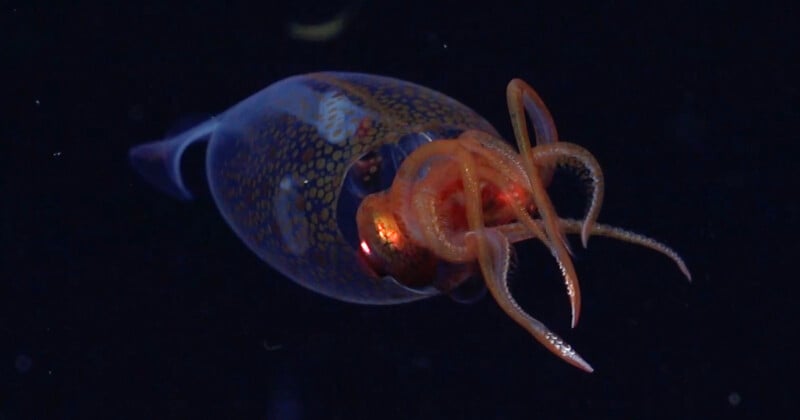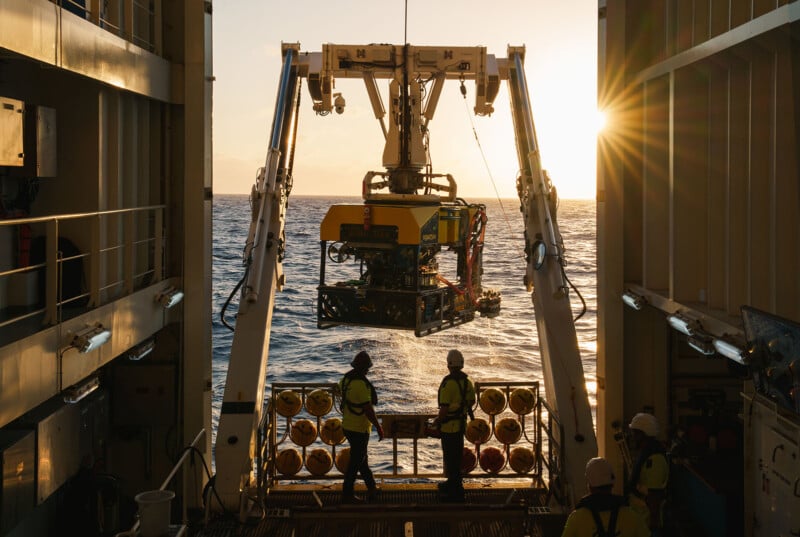Colossal Squid Filmed in Wild for First Time Ever

An underwater drone has captured the first-ever video footage of one of Earth’s most mysterious invertebrates, the colossal squid.
In March, a juvenile colossal squid, measuring 12 inches (30 centimeters) drifted across the Remotely Operated Vehicle (ROV) camera’s field of view at a depth of 600 meters (1,968 feet) near the South Sandwich Islands in the south Atlantic. The creature’s translucent body is mottled with brown spots.
Onboard the research vessel Falkor, the team of scientists from the Schmidt Ocean Institute and the University of Essex watched in real time as the footage was beamed up to them. Chief scientist Dr. Michelle Taylor says initially the team were unsure exactly what they were seeing, but kept filming because it was “beautiful and unusual.”
The discovery is a landmark moment. Despite the colossal squid being formally identified 100 years ago, no one has ever filmed one alive in its natural environment.
“It’s exciting to see the first in situ footage of a juvenile colossal and humbling to think that they have no idea that humans exist,” Dr. Kat Bolstad, a deep-sea cephalopod biologist at Auckland University of Technology, who was called upon to verify the footage shortly after returning from her own Antarctic expedition, tells the BBC.


For decades, most of what scientists know about colossal squid has come from fragments — usually the unlucky leftovers inside the bellies of sperm whales, their only known predator. Occasionally, fishermen have hauled dying adults to the surface, often tangled on hooks while attacking prey. But until this encounter, no human eye had ever witnessed the animal alive, undisturbed, and swimming freely in the ocean’s shadowy depths.
Adult colossal squid, Mesonychoteuthis hamiltoni, are the heavyweight champions of the invertebrate world. Estimates suggest they can grow up to 23 feet (7 meters) long and weigh as much as 1,100 pounds (500 kilograms). Equipped with the largest eyes in the animal kingdom — bigger than a basketball — and arms lined not only with suckers but also swiveling hooks, they are perfectly engineered for life in the abyss.

Dr. Bolstad explains that the colossal squid’s vast, dark home is likely part of why the species remains so elusive. “They’re very aware of their surroundings, because any disturbance in the water column around them might mean a predator,” she tells The New York Times. The colossal squid’s adaptations — including its eerie, transparent early life stage — seem designed to help it drift undetected until it matures into a reddish, opaque adult and sinks deeper into the ocean.

Just weeks earlier, the same team also filmed the first-ever footage of a glacial glass squid, another elusive cephalopod. Dr. Jyotika Virmani, the executive director of the Schmidt Ocean Institute, sees these back-to-back discoveries as a vivid reminder of the ocean’s hidden abundance.
“These unforgettable moments continue to remind us that the ocean is brimming with mysteries yet to be solved,” she tells the BBC.
Image credits: Schmidt Institute